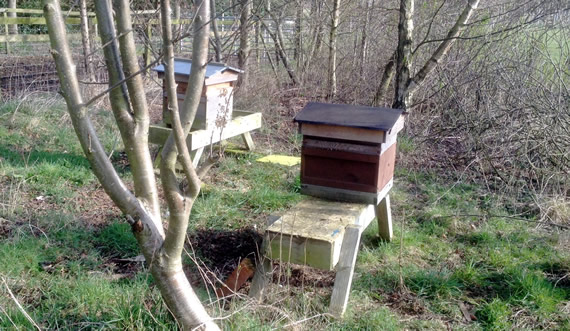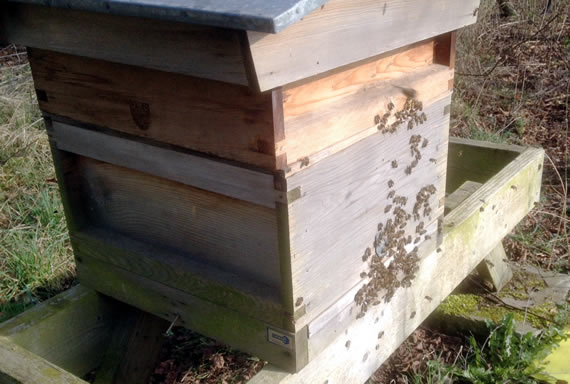Posted: Wednesday 30 March, 2016
When we moved to Dalmore in 2010 the prospect of establishing an apiary was something that excited us all. We got our first bees in 2011, and since then my dad has been looking after them with very little help from the rest of us, other than to eat the honey.
Last year he decided he'd like a break from the responsibility, so over the winter I took a beginner's bee-keeping course at the East of Scotland Beekeepers' Association, and now have the terrifying prospect of taking charge of the apiary!
We have three colonies currently, and not much information about them other than "that hive's a bit aggressive". So it's a bit of a voyage of discovery. :-)
 Apiary in March 2016
Apiary in March 2016
Each colony now has a number, so we can talk about them without waving a finger in the general direction of the hive we're referring to, and I've started a record sheet for each hive. Here's a PDF for anyone who might be interested:
Until yesterday the sum total of my activity was hefting the hives in February to get a feel for how they'd coped over winter - well enough was my conclusion, hive 3 was really quite heavy, the other two heavy enough not to be concerned.
I'd also been watching out to make sure they were flying in March when the weather was good - they were, with good levels of activity at each hive, and the highest level at hive 3.
An inspection was needed to be sure there was queen activity, that stores were in place and there weren't any potential problems developing. Yesterday morning the weather was clear and sunny, a little cool but warming quickly, so I did my first ever inspection, accompanied by the old man for moral and practical support.
It was a learning experience. We started with hive 1 (of course!), which was relatively docile. There were clear signs of queen activity, but in my beginner's haze I didn't look closely for eggs or larvae, but did see capped brood cells. Hive 2 was much the same, slightly more populous and active, and we spotted the queen with the yellow dot on her back. We also found some honey stores in a couple of frames.
Hive 3 was absolutely bulging with bees. There are only 2-3 brood frames empty, and it was so active we didn't do a thorough inspection, just checked a couple of frames.
 Hive 3
Hive 3
We added supers to all three hives, and would certainly hope for a honey crop from hive 3.
This week I will contact my local mentor to ask if he'll do an inspection with me, specifically for hive 3. I'm reasonably happy to work with the other 2 hives, but lack the confidence to handle the burgeoning colony in hive 3 at the moment.
So all three hives appear to be in good health, which is the main thing at this time of year, all appear to have healthy queens, and I survived my first inspection.
- Previous « Corgi floof and nosebleeds
- Next Wool but no lambs »
Comments
Comments are now closed for this post.









lewis morgan
Tuesday 5 April, 2016 at 4:20pm
Dan-One of the best tools a beekeeper can have is a spraybottle of peppermint flavored 2x1 sugarwater! May have to keep it in the refrig during the summer but when you have a big monster hive and two mediums close by, after checking for AFB you can take 2 frames of mostly capped brood after checking 2 or 3 times that the queen is not on them and spray them on both sides with your sprayer and put them in the middle of your middle- sized colonies!! They will never fight as long as they smell the same. T he forager bees will return to their home colonies.I generally trade empty combs with mediums and put them on the outter edge of the big colony, Seven to ten days I do the same thing again! In three weeks all three should be monster colonies!! T o keep your bees from swarming and to get a medium honey-crop you can run your hives with q-ueen excluders and pull a frame of capped brood every single week and replace with a frame of foundation . They will try to fill this empty space up assoon as they can! You can use these frames of brood and bees to make up nucleus colonies and use the extra bees to combine with your big colonies in the fall or sell them for a good price in the summer.Check on You-tube on some of the really ingenious things they do there!! Good luck with your bees!!